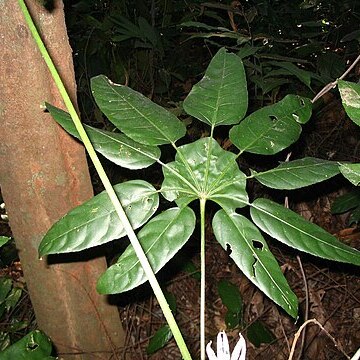Shrub or small, sparsely branched tree up to 10 m, branches stout with small prickles, young parts rufous-furfuraceous, cataphylls prickly. Leaves crowded at the ends of the shoots, digitately compound; leaflets usually 7-9; petioles c. 60 cm, striate, sometimes with small prickles or bristles, dilated into a clasping base, ligule with two lanceolate lobes; petiolules united for all or most of their length by a foliaceous web; leaflets oblong-lanceolate or elliptic, up to 30 by 10 cm, apex acuminate, base cuneate or rounded, margin finely serrate especially in the upper part, principal veins arched-ascending, prominent. Inflorescence a large terminal panicle, often overtopped by lateral shoots; rachis to 60 cm, slightly prickly or not, bearing branches along its length and usually ending an umbel of branches, bracts caducous or persistent; secondary branches (peduncles) c. 10-18 cm, sometimes with 1 or few bracts along their length and terminating in spherical umbellules of 40-50 flowers; pedicels c. 20-35 mm, slender. Calyx an irregular obsolete rim. Corolla hemispherical, c. 6 mm high, falling as a calyptra, petals c. 7-10. Stamens c. 7-10, filament flattened c. 2.5 mm, anthers broadly triangular, c. 3 mm long. Ovary at anthesis broadly obconic, usually rufous-furfuraceous, c. 7-10-celled; disk broadly conical surmounted by the connate styles, stigmas slightly swollen. Fruit subglobose 1.5 by 1.25 cm, surmounted by the stylopodium and connate styles.
More
A shrub or small tree. It can grow 10 m tall. The branches have scattered stout spines. The leaves are alternate and crowded at the ends of branches. They have lobes like fingers on a hand. The leaves are 60 cm across with 7-9 lobes. The flowering shoots are in groups 60 cm long with 6-12 secondary branches ending in 30-50 flowering clusters.

